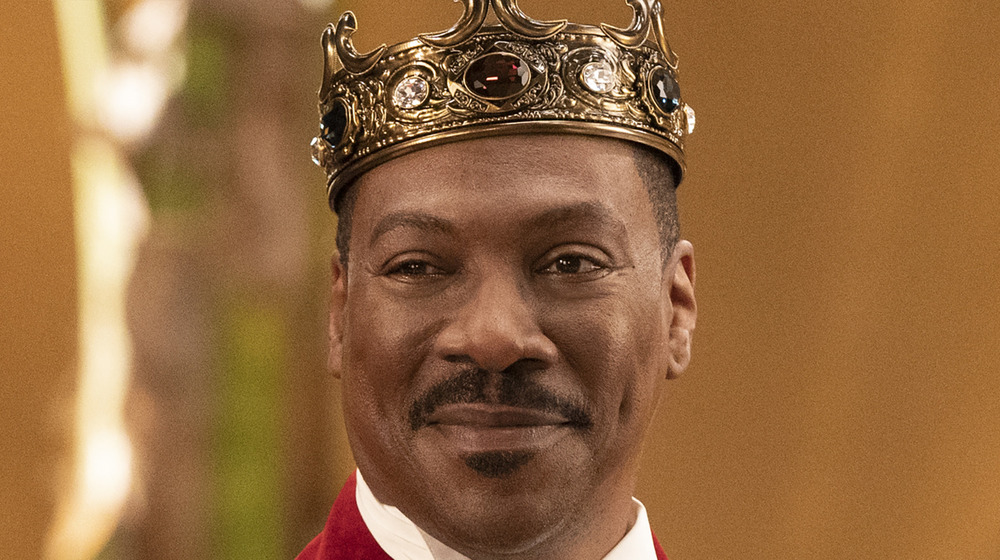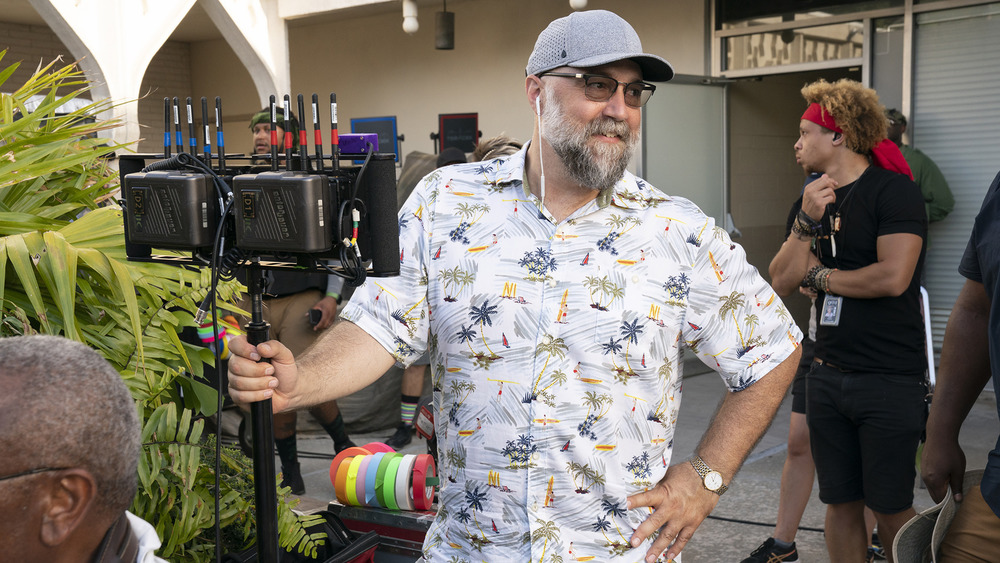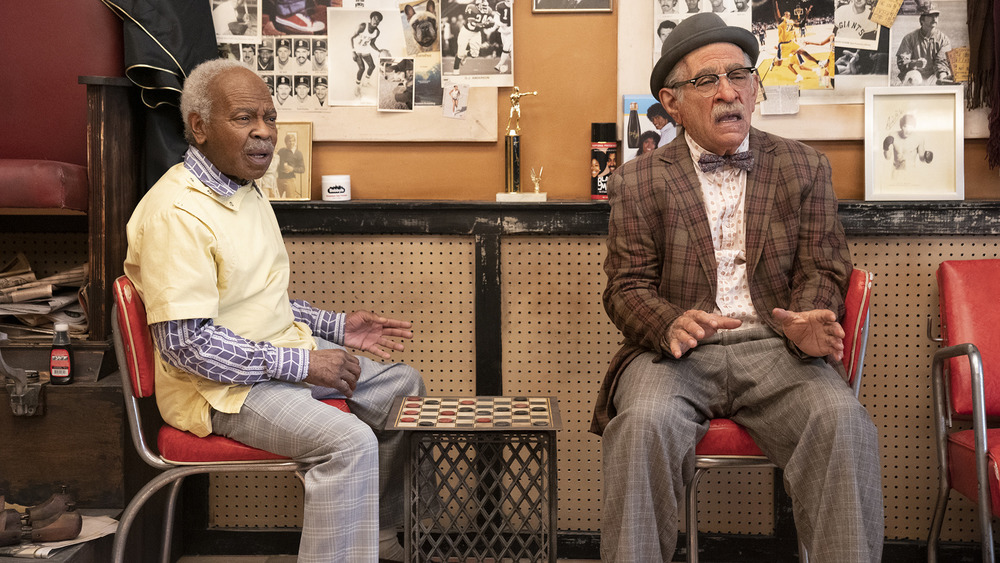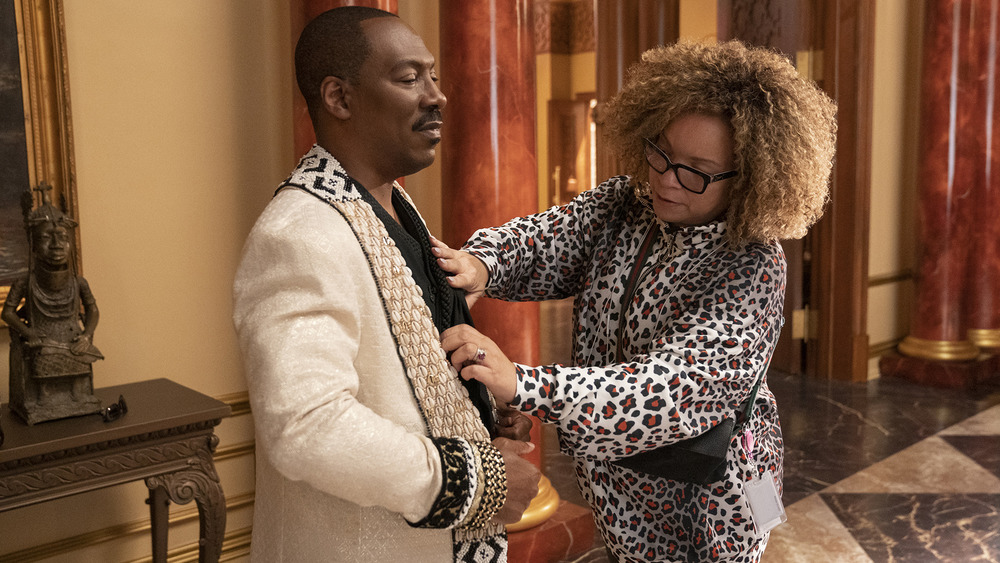What Coming 2 America's Director Revealed About The Hit Sequel - Exclusive Interview
It took a while, but there's no doubt about it: the crown prince of Zamunda is back. Thirty-three years after Coming to America charmed audiences with an African royal's trip to Queens in search of true love, Eddie Murphy returns to the screen as Prince — ahem, King Akeem — for a brand-new adventure that reunites the major players from the first movie. That's right: In addition to Murphy, Coming 2 America features Arsenio Hall, Shari Headley, James Earl Jones, John Amos, Paul Bates, Vanessa Bell Conway, and more. For the sequel, everyone is back.
Well, almost everyone. For Coming 2 America, Hustle & Flow and Dolemite Is My Name filmmaker Craig Brewer steps into the director's chair previously occupied by comedy legend John Landis. It's hard to think of a more intimidating task. There decades' worth of expectations riding on the movie, and Brewer has to make sure that newcomers like Jermaine Fowler's Lavelle and Kiki Layne's Meeka resonate with viewers just as well as the beloved classic cast. Oh, and he has to make sure people laugh. It's a lot of work.
Brewer, however, seems anything but intimidated — and he told Looper why. A few days before Coming 2 America's big digital premiere, the director told us all about working with Eddie Murphy, how he and his crew worked to establish Zamunda's unique culture, what it was like directing his first straight comedy, and more.
What Craig Brewer learned from directing Coming 2 America, his first big comedy
It's been 33 years since the first movie came out. Why is now kind of the right time for a Coming to America sequel?
I think there are a lot of reasons for that. One reason, I think, came up just in this last year. I mean, I've heard from so many people that have come up to me and said that they need Coming 2 America. They want to see some old friends. They want to laugh again. And as much as we would like to say that's why we did the movie in the first place, it just took on, I think, a heavier connotation during these times. So there's that part.
For me, I think the one advantage of the movie now being 33 years later is that Eddie himself has changed. Just like his character, Akeem, the days of Eddie in Delirious and Raw, he's not in those days anymore. Father. He's a grandfather. There's a lot of comedy and accessibility to mine there, especially for people my age who were teenagers when we saw Coming to America. Now I've got teenage kids.
I think that's the benefit of the movie being three decades later as opposed to just a few years after the first Coming to America. We can go "Oh, well, what happened to Akeem and Lisa once they entered that fantasy bubble at the end of Coming to America? Is something going to pop this bubble? And actually, does it need to be popped? Have they gotten too comfortable? Are they conforming too much and do they need to start listening to their kids a little bit more?"
So, there are a lot of reasons for Coming 2 America, but mainly we're just here for Randy Watson and Sexual Chocolate. I think we just want a movie to happen so we can then see Randy Watson.
This is your first big, broad comedy movie, right?
It is, yeah.
What did you learn from that experience as a director?
I think trust. Trust and patience. You want to create an environment on your set where people trust you, where they want to come in and they want to have a good time. It's a high-wire act to be funny on a movie set. There's not an audience there laughing. Everybody has got to be very quiet. It's very hard to know what works and what doesn't work, and the same kind of trust and patience, I think, needs to happen in editorial, where you look at so many different things that could be funny and decide which one should go in and which one shouldn't.
Sometimes, there'd be something that would be maybe bordering on crude and we'd go like, "Oh, that's pretty funny." But then we would test it for an audience and they're like, "We don't like the way she comes off in that scene." I was like, "Oh, that's so interesting. We thought it was something, but the audience is thinking something different."
You can feel like you've lost your way a lot of times with the comedy. But the biggest lesson is stimulation, I think, in any kind of form, like if you're listening to music or activities or comedy, can kind of wear off after a bit. You can almost tire of even the best of comedy. I think it's important to hitch your wagon to a little bit of heart as well. I think that's something that was very important to me going into this movie. It's like, "I'd kind of like also for people to be a little emotional about Coming 2 America," and work the family dynamic into the story that way we did. I'm proud of those moments because I think that they actually work.
What it's like directing Eddie Murphy, and why some great improvised moments didn't make it into Coming 2 America
You worked with Eddie before on My Name Is Dolemite, which is a different kind of project. It's a biopic, as opposed to a comedy. Was your experience with him different on the two projects? What's it like directing him in a comedy versus a drama?
Well, it's funny, because as much as people could say that Dolemite was a drama, it definitely had so many comedians in it that it didn't feel too different. However, I will say that working with Eddie on Dolemite, I could see certain elements in his performance that I had not seen in a movie before. There were certain subtleties that I think that he brought to it because he wasn't trying to entertain us 100% of the time he was on the frame. He could sometimes be vulnerable. He could sometimes be scared. That was kind of a pleasant thing for fans of his to see, because we've always known that he had that in him.
But then moving into Coming 2 America — and we did it immediately after Dolemite. I mean, I think that we finished the edit on Dolemite and then we immediately began prep on Coming 2 America. It was really back-to-back. It was a little bit more fun because it's kind of like that second child. You're really worried about your relationship on the first movie. On the second one, I could come out to his trailer and kind of chill and talk with him for a bit, and then we'd go to set and have some fun. I think that I would have a different answer for you about what it would be like working on Coming 2 America had I not just done Dolemite.
You have so many talented comedians and improvisers in the movie. Were there any ad-libs that you wish you could've included, but you couldn't fit in for whatever reason?
Oh, there's so many. There's so many. I mean, the barbershop alone was just... We just couldn't fit all the improv in there. Arsenio in particular is just hilarious. I mean, he comes up with a ton of stuff.
I think that's the hardest thing with comedies, which joke are you going to use and which take are you going to use? People laugh to 80% with this one, 90% with this one, but which one's faster? There are all kinds of decisions that you have to make to choose which one goes in. Even Leslie Jones in this one scene was just coming up with these amazing zingers. She had to basically respond with a different answer every time. I think we did 10 takes and she had a different answer every time. But yeah, we couldn't fit it all in there.
Music is such a big part of your filmography, with Hustle & Flow, then Footloose. Can you talk a little bit about how you put the musical numbers and the dance sequences together, and how you kind of made sure to honor both the original movie, and also the African inspirations behind them?
Yeah, I mean, we always knew that we wanted to have a lot of nods to the kind of movement that Paula Abdul created in the first Coming to America. I mean, that music number is a stunning dance sequence in the first movie. And so I always knew that during our funeral sequence that we were going to have to have a real party and have a really good time.
I remember when I was first brought on to the project and I went into Paramount and they said, "Well, is there anything you'd like to change in the script, or is there anything you'd like to add?" I was like, "Well, the first thing I want to do is, Oha needs a number." They were like, "Oha? Oh, you mean the guy that announces everybody?" I was like, "That's Oha. He's singing 'She's Your Queen' in the first movie. We've got to be able to give him something new in this."
I was like, "I think I can create this music number that can get Lavelle and Izzi's daughter involved with each other kind of an organic way by way of Paul Bates playing Oha." I was like, "And I'd like to use this number," and I had a boombox with me and I played Prince's "Gett Off." And then they got really excited.
It's really funny because Shari [Headley]'s son was on set one day and he was like, "Man, I love this song," and he didn't know that it existed before because he's young, and then I played him the original Prince song. He's like, "I think I like ours better." I was like, "I bet that's a compliment but no, Prince is always going to be better."
How Craig Brewer and Ruth Carter expanded on Zamundan culture for Coming 2 America
Despite the title, we actually spent a lot more time in Zamunda than America in the sequel. Can you talk a little bit how you went into developing Zamunda's culture and aesthetic, as well as making sure it was funny without descending into caricature or racial stereotypes?
I know that a lot of the things that people would probably get mad about at Coming to America, the first movie, and probably even our movie, is the ugly American idea of Africa. You know what I mean? I think a lot of the humor in the first movie was based off of that. I can't speak for the creators on it, but the humor in the movie plays off of African-Americans in Queens not having the knowledge or a connection to what's happening in wherever Zamunda is. Well, we live in a different time now. Now, I think that we know a lot more about Africa as a continent as well as the various nations and places within Africa.
The first call was really to [Black Panther costume designer] Ruth Carter in terms of the costumes and saying, "Look, Ruth. You did a superhero movie, but you bring such respect to the costumes by way of the cultures that you embraced emanating from Africa. I know we're doing a comedy, but we have to do that with Coming 2 America because Coming 2 America is more than just a movie to make people laugh." People have a genuine love of the first movie. It's an important movie, especially to African-American culture. It was a movie that in 1988 was showing wealth and royalty with an African family that had never.... It's hard for me to try to tell young people that used to not be. There was a time where it was like, "Wow, look at this movie," and we needed to live up to that standard.
And so yes, Zamunda still is going to be a funny place, but we preferred that the funny not be in poking fun at Zamunda all the time, but talking about its old, antiquated traditions, and showing that it's also a place where when you introduce somebody in court, sometimes a music number comes on and people come out dancing. To me, that felt very much in the context of the Zamundan arts of the original Coming to America. I know why everybody wanted to name it Coming 2 America, but I was like, "Yeah, it seems like this is more like Back to Zamunda than anything else." I'm glad that people are responding to that because I think there could be more done in the world of Zamunda.
Aside from Ruth Carter, whose costumes in this movie are breathtaking, did Wakanda or Black Panther influence this movie at all?
None. As matter of fact, that's something that actually Ruth was really big on. She wanted that to be two different nations, two different places. If you really look at the first Coming to America, it does have a little bit more of a colonial look, a little bit more statesman-like. People are wearing suits. There wasn't a tremendous amount of African-inspired wear in the first movie. The palace gowns were a little bit more European in the first movie. That's where I think Ruth saw an opportunity to really bring a lot more of the design and contemporary African designers to Zamunda. I think she did a fantastic job with it.
I mean, there are some outfits that I'm just amazed at. There's this outfit that KiKi Layne playing Meeka and Jermaine Fowler playing Lavelle wear that is this white and green outfit that's basically like Puma jump wear that has been cut and repurposed. I would look at those and it was just like, "Why isn't every kid in America wearing this?" It was just the most amazing outfit I've ever seen. It's just like Ruth's got her ear to the ground and she knows about trends that are happening on the other side of the globe. It was really inspiring every day to show up and see people in these costumes. It's stunning.



